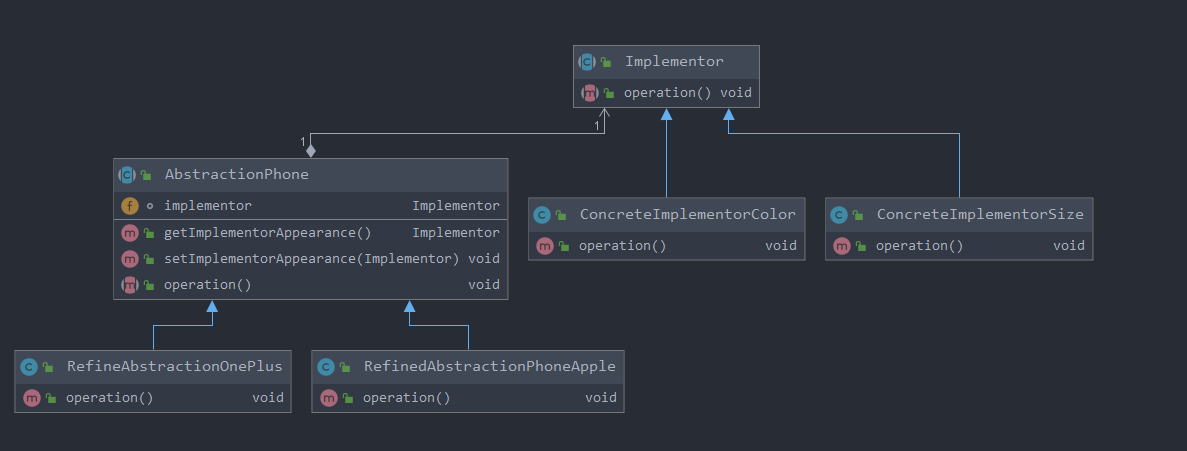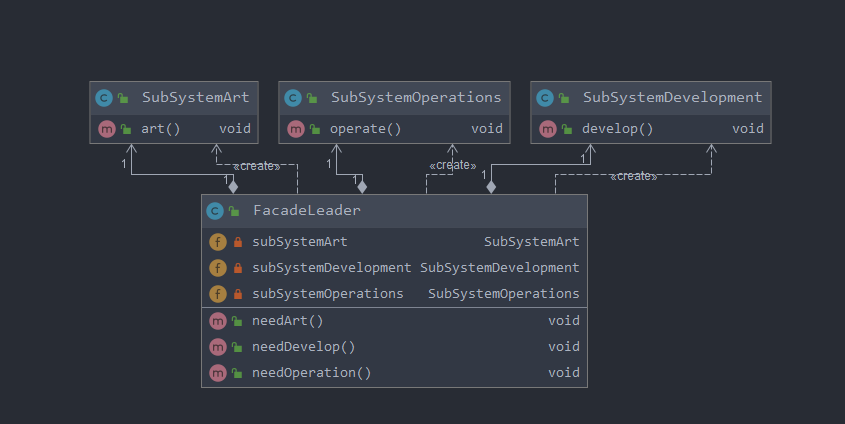您好,登錄后才能下訂單哦!
您好,登錄后才能下訂單哦!
本篇內容主要講解“什么是結構型模式”,感興趣的朋友不妨來看看。本文介紹的方法操作簡單快捷,實用性強。下面就讓小編來帶大家學習“什么是結構型模式”吧!
橋接模式的目標是將抽象與實現解耦,使得兩者可以獨立地變化。橋接模式通過在公共接口和實現中使用繼承來達到目的。
比如手機可以有多個品牌,那么可以把手機抽象出來;每個手機可以有多種實現,比如顏色不同、尺寸不同、性能不同和系統不同等等。
Abstraction:抽象類
Implementation:抽象的實現類
Refined:擴充的抽象類
Specific Implementation:具體實現類。

Abstraction
public abstract class AbstractionPhone {
Implementor implementor;
public Implementor getImplementorAppearance() {
return implementor;
}
public void setImplementorAppearance(Implementor implementor) {
this.implementor = implementor;
}
public abstract void operation();
}Refined
public class RefineAbstractionOnePlus extends AbstractionPhone {
@Override
public void operation() {
System.out.println("一加手機");
implementor.operation();
}
}public class RefinedAbstractionPhoneApple extends AbstractionPhone {
@Override
public void operation() {
System.out.println("蘋果手機");
implementor.operation();
}
}Implementor
public abstract class Implementor {
public abstract void operation();
}Concrete Implementor
public class ConcreteImplementorColor extends Implementor {
@Override
public void operation() {
System.out.println("手機有關顏色的實現");
}
}public class ConcreteImplementorSize extends Implementor {
@Override
public void operation() {
System.out.println("有關手機尺寸大小的實現");
}
}Client
public class Client {
public static void main(String[] args) {
AbstractionPhone phone = new RefineAbstractionOnePlus();
phone.setImplementorAppearance(new ConcreteImplementorColor());
phone.operation();
phone.setImplementorAppearance(new ConcreteImplementorSize());
phone.operation();
}
}組合模式顧名思義就是把一組對象組合成一個復雜的單一整體,比如把對象組合成樹形或者圖形結構。
最簡單常見的就是公司里面的人員分布,所有的員工是很復雜很多的,但是從CEO到最底層的員工會形成一個樹結構。

Component
public abstract class ComponentEmployee {
String name; //名字
String position; //職位
String salary; //薪水
//報告人員情況
public void report() {
String str = "Employee{">Composite
public class CompositeLeader extends ComponentEmployee {
//這里本來應該是private,然后外部通過get獲取才合適,為了演示
List<ComponentEmployee> subComponentEmployees;
public CompositeLeader(String name, String position, String salary) {
super(name, position, salary);
//new一個下一層員工的List集合
subComponentEmployees = new ArrayList<>();
}
@Override
public void addEmployee(ComponentEmployee componentEmployee) {
subComponentEmployees.add(componentEmployee);
}
@Override
public void deleteEmployee(ComponentEmployee componentEmployee) {
subComponentEmployees.remove(componentEmployee);
}
@Override
public void report() {
System.out.println("我的情況:");
super.report();
System.out.println("我手下員工的情況");
for (ComponentEmployee e: subComponentEmployees) {
e.report();
}
}
}Leaf
public class LeafStaff extends ComponentEmployee {
public LeafStaff(String name, String position, String salary) {
super(name, position, salary);
}
//手底都沒有員工,增加和刪除操作就空實現,注意這里的空實現
@Override
public void addEmployee(ComponentEmployee componentEmployee) {
}
@Override
public void deleteEmployee(ComponentEmployee componentEmployee) {
}
@Override
public void report() {
super.report();
}
}可以注意到葉子結點里面有兩個是空實現(因為最底層的員工手下沒有其它員工),這樣是不太安全的做法。很簡單,只要Component 中的兩個抽象方法刪掉即可,然后在Composite 里面是新增方法,而不是重寫方法。
門面模式的目的是為復雜的子系統提供單一的統一的接口,這樣客戶端只需要了解結果,不必了解各個子系統間是如何運作的。
比如甲方盡管給產品經理提需求,他只要成品,至于說公司的內部是如調配如何完成,客戶一概不理也沒必要知道。
Facade:子系統接口
SubSystem:子系統中定義的類

Facade
public class FacadeLeader {
private SubSystemArt subSystemArt = new SubSystemArt();
private SubSystemDevelopment subSystemDevelopment = new SubSystemDevelopment();
private SubSystemOperations subSystemOperations = new SubSystemOperations();
//暴露給外界的方法,外界不知道具體內部是誰來干,干什么
public void needArt() {
subSystemArt.art();
}
public void needDevelop() {
subSystemDevelopment.develop();
}
public void needOperation() {
subSystemOperations.operate();
}
}SubSystem
public class SubSystemArt {
public void art() {
System.out.println("美工部門正在畫圖");
}
}public class SubSystemDevelopment {
public void develop() {
System.out.println("開發部門正在開發");
}
}public class SubSystemOperations {
public void operate() {
System.out.println("運維部門正在測試!");
}
}Client
public class Client {
public static void main(String[] args) {
FacadeLeader facadeLeader = new FacadeLeader();
System.out.println("我們需要這個需求");
facadeLeader.needArt();
facadeLeader.needDevelop();
facadeLeader.needOperation();
}
}享元模式,聽起來很高大上,但是實際上就是共享對象的一種模式。目的是通過在相似對象間的共享狀態來減少內存占用。
比如王者里面的小兵在一定時間內攻擊、雙抗,移動速度都是一定的,那么就是通過享元模式來減少對象的生成,從而使得內存消耗較少。而對于那些打完主宰后的兵,因為不是重復的,所以可以作為非共享的狀態。
Flyweight:抽象享元類
Concrete Flyweight:與其同伴共享狀態的享元對象
Unshared Concrete Flyweight:不共享其狀態的享元對象
Flyweight Factory:享元工廠類
Flyweight
public abstract class FlyweightSoldier {
public abstract void play();
}Concrete Flyweight
public class ConcreteFlyweightNormalSoldier extends FlyweightSoldier {
String type;
public ConcreteFlyweightNormalSoldier(String type) {
this.type = type;
}
@Override
public void play() {
System.out.println("生成小兵:" + type);
}
}Unshared Concrete Flyweight
public class UnsharedConcreteFlyweightGeneral extends FlyweightSoldier {
@Override
public void play() {
System.out.println("根據不同情況生成的龍");
}
}Flyweight Factory
public class FlyweightFactory {
private Hashtable<String, FlyweightSoldier> flyweights = new Hashtable<>();
public ConcreteFlyweightNormalSoldier getSoldier(String key) {
if (!flyweights.contains(key)) {
flyweights.put(key, new ConcreteFlyweightNormalSoldier(key));
}
return (ConcreteFlyweightNormalSoldier) flyweights.get(key);
}
public UnsharedConcreteFlyweightGeneral getGeneral(String key) {
flyweights.put(key, new UnsharedConcreteFlyweightGeneral());
return (UnsharedConcreteFlyweightGeneral) flyweights.get(key);
}
}這里注意了,因為普通小兵是共享的,所以當有key的時候就不用再new一個小兵,直接返回即可;而對于特殊小兵來說,不管是否有key,都會new一個兵put進去。
Client
public class Client {
public static void main(String[] args) {
FlyweightFactory factory = new FlyweightFactory();
for (int i = 0; i < 3; i++) {
System.out.println("第" + i + 1 + "波兵線");
factory.getSoldier("近戰兵").play();
factory.getSoldier("弓箭手").play();
factory.getSoldier("法師兵").play();
}
//到這里其實只創建了三個對象
for (int i = 0; i < 2; i++) {
System.out.println("第" + i + "波特殊兵線");
factory.getGeneral("減雙抗龍").play();
factory.getGeneral("減攻速龍").play();
}
//到這里創建了7個對象,3 + 4
}
}到此,相信大家對“什么是結構型模式”有了更深的了解,不妨來實際操作一番吧!這里是億速云網站,更多相關內容可以進入相關頻道進行查詢,關注我們,繼續學習!
免責聲明:本站發布的內容(圖片、視頻和文字)以原創、轉載和分享為主,文章觀點不代表本網站立場,如果涉及侵權請聯系站長郵箱:is@yisu.com進行舉報,并提供相關證據,一經查實,將立刻刪除涉嫌侵權內容。